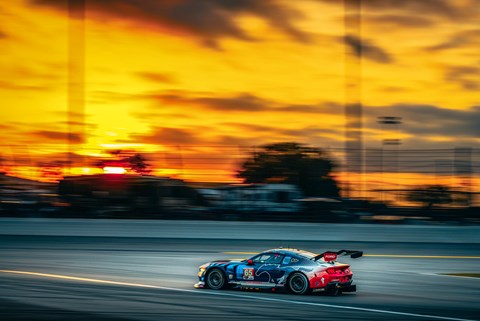► We join Ford at Mustang GT3’s debut
► Ford Performance’s team at 24 Hours of Daytona
► Just the start of Ford’s massive motorsport push
It’s been a tough night for Ford at the 24 Hours of Daytona, and now factory driver Harry Tincknell is preparing for the final stint in the sole surviving Mustang GT3 on its competitive debut.
Dark shades shield eyes weary after just 45 minutes’ sleep, and Tincknell flinches when I shake his hand – it’s blistered from gripping the Mustang’s steering wheel at 175mph through Daytona’s heavily banked curves, then hustling it through the tighter infield that punctuates this 3.56-mile lap.
Despite the pain, the fatigue and the journalist, the Englishman wears the pressure lightly, seeming as alert and relaxed as when we first chatted two days earlier.
‘Now we just need to bring it home,’ says the 32-year-old, shouting over cars that buzz past the pit garage. ‘Some big championship rivals went out early, so we need to get the points, but the Corvette is 18 seconds up the road – catching that would be amazing.’
Next thing the number 64 Mustang rumbles in, team-mate Christopher Mies jumps out and Tincknell folds his lanky frame into a web of tubes, bars and netting like he’s wandered into a Spider-Man versus Doctor Octopus fight scene.
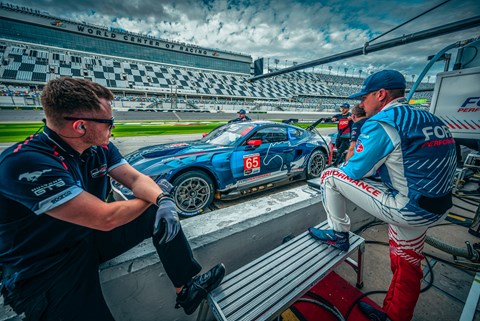
A swarm of activity from his pit crew, a spin of slicks and flare of V8 and he’s gone into the searing Florida heat, Corvette on his kill list.
Much as a GM scalp appeals, Ford will do more than chase domestic makers round domestic racetracks with its new Mustang motorsport programme.
Now its Camaro and Challenger road-car rivals have ended production, the world’s best-selling sports car is taking on European royalty including the Ferrari 296 GTB, Porsche 911, Aston Vantage and Lamborghini Huracan everywhere from Le Mans to Bathurst, the Nürburgring to Spa. ‘Elevating Mustang’ is a common refrain.
Daytona marks the start of all that in the Mustang’s 60th anniversary year – a day-long baptism of fire that doubles as round one of the 11-round IMSA WeatherTech SportsCar Championship.
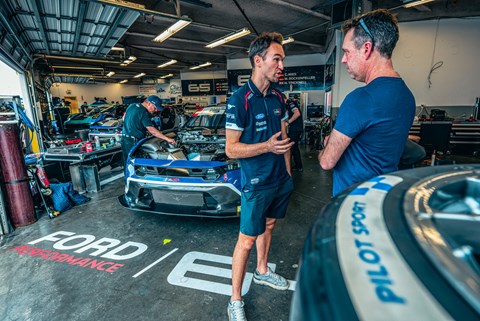
Midday Friday, a little over 24 hours before the race begins and I’m tiptoeing around expensive carbonfibre body panels on the floor of the Ford pit garage.
Ford Performance boss Mark Rushbrook is here, so too Larry Holt, the dreadlocked boss of independent outfit Multimatic, which is charged with building the car and running the race programme.
Nearby I bump into Brit Matt Wilson, director of M-Sport. Famous for its Ford rally cars, M-Sport is now contracted to build the Mustang’s 5.4-litre V8, having learnt a decent amount about V8 racecars from its Bentley GT3 programme.
Appropriately numbered 64 and 65 works cars sit side by side in dark blue, white and red liveries, the names and nationalities of their three-driver crews displayed overhead.
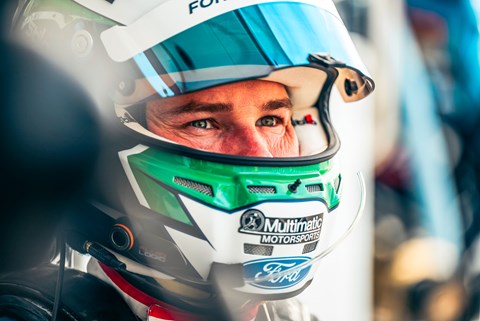
Tincknell joins German team-mates Christopher Mies and Mike Rockenfeller in 64; Joey Hand (US), Dirk Müller (Germany) and Frederic Vervisch (Belgium) are across the garage in number 65. (Customer team Proton Competition is nearby, prepping the pale blue number 55.)
Ford and its Multimatic technical partners have all been here before, of course, racing the Ford GT supercar from 2016 to 2019. Less well known is that the GT campaign rose from the ashes of Project ⊲ Silver, a Mustang study that Ford cancelled in 2013 – too much frontal area, they said; too many modifications to really be a Mustang at all. Besides, Mustang is rarely associated with endurance racing.
New FIA GT3 rules persuaded Ford to look again. (Continuing the long tradition of impenetrable endurance-racing logic, GT3 cars race in IMSA’s GTD Pro and GTD category – the difference between GTD Pro and GTD being the rating of the drivers. Meanwhile, pure-bred prototypes fight in premier GTP or second-tier LMP2 classes.)
With its wheels, carbonfibre doors, bonnet and one front wing stripped off, the guts of a racecar that shares its bodyshell if little else with the production Mustang Dark Horse are laid bare.
There’s trick double-wishbone suspension and spool-valve adaptive shock absorbers all round, a rear wing like a JCB digger bucket and a diffuser the size of a storm drain. The naturally-aspirated V8 sits so low and is pushed so far back in the chassis it could’ve been punched into the bulkhead, while the transmission now lives between the rear wheels, not in a bellhousing on the back of the block.
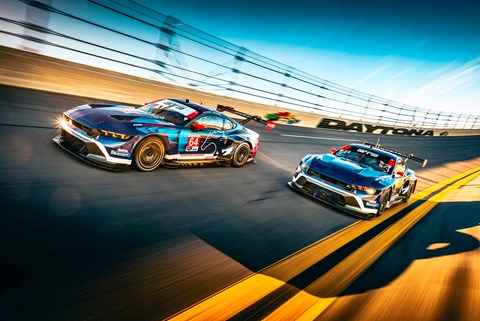
Want more Mustang goodness? The July 2024 issue on sale now is packed with Ford icons – click here to subscribe and get access to our digital issue!
Tincknell has been onboard since the start of development two years ago, pounding laps in the simulator, driving the first roll-out with Hand and offering references both from his Ford GT and – more relevantly – front-engined Aston Vantage GTE days.
He qualified last of 13 GTD Pro runners in 50th out of 59, but it’s tight – his 1:45.840 is 1.5 seconds off GTD Pro polesitter Seb Priaulx’s time in a 911, yet the Guernseyman is 27 places up the grid. Ultimately the gap matters little in a 24-hour race and the Ford man is largely happy with his new car.
‘The V8 is really meaty – top speed and acceleration are strong – and it’s good at getting the power down but the ABS has been a little inconsistent and it’s not the fastest car in the corners compared with some mid-engined rivals,’ he sums up. ‘Then again, the Ford GT was so good through corners we were restricted on power [by the Balance of Performance adjustments], which leaves you very exposed on straights, so in some ways that’s not so bad.’
The ABS, traction control and a general set-up philosophy further broadens the Mustang’s approachable dynamic for non-factory drivers – given only customer GT3 teams are permitted in the World Endurance Championship that includes Le Mans, that’s key.
‘This car rewards smoothness and consistency, it doesn’t like to be over-driven like a Porsche 911, and we’re finding gentlemen drivers are stepping into it and getting much closer to the pace than they do with other manufacturers’ cars,’ Tincknell confirms.
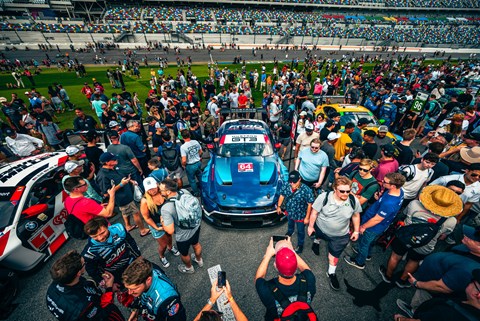
Fast forward 21 hours and Daytona is packed. It takes 30 minutes to move from the paddock to the Open Grid Fan Walk to get up close with cars and drivers. It hasn’t been this busy in years, comment regulars. I don’t even find the Mustangs in the melee, and instead waddle like a penguin in a huddled pack, only partially in control of my own trajectory.
There’s a better vantage point from the grandstands as film producer Jerry Bruckheimer waves the flag for the rolling start at 1.41pm. The ground shakes and my seat tingles like a tuning fork as cars stream off the banking into the flat, twistier infield.
Initially cars are clearly separated by classes, but with prototypes currently lapping in the 1min 36sec bracket, the LMP2s around six ⊲ seconds slower and the GTD cars a further five or so seconds off LMP2 pace, it’s not long before the pack is shuffled.

Carnage inevitably ensues, but mostly it’s confined to the LMP2 runners. Around 50 minutes in there’s a three-car LMP2 pile-up at the Bus Stop chicane. A minute later another LMP2 loses control, collecting a Lexus GTD as it exits stage left. Just prior to the two-hour mark yet another LMP2 bins it. Steady lads, steady.
Want more Mustang goodness? The July 2024 issue on sale now is packed with Ford icons – click here to subscribe and get access to our digital issue!
At least the Mustangs are keeping their heads. By 3.30pm #65 is second in class, and around 6pm Tincknell is leading in #64, despite a bootlid that peels back like a sardine tin – the weakness snuck through testing because the cars didn’t run in turbulent air washing off large packs of rivals.
This early on, track positions are academic and rather muddled by pitstops – Tincknell’s car has done only six stops, some rivals are now up to 10 – but the Mustang’s speed is real, setting some fastest GTD laps despite struggling to run as well as it should in hotter temperatures (intake restrictors barely bigger than wedding rings throttle it where turbo cars have more sophisticated computer-controlled restrictions – thankfully this will change to universal torque sensing from the driveshafts).
At dusk I wander past steaks grilling on food stalls and beyond fans perched on top of motorhomes, surprised to discover a huge lake in the middle of the track – the water table has long since filled the scar left by machinery scraping earth for Daytona’s 40-foot wide, 31º banking.
It’s a cool spot to watch – and listen – from as cars come off the Turn 7 banking. LMP2 cars rasp like trombones sliding down a scale, prototypes have a more complex, deeper sort of fizz and the Mustang’s thunderous V8 rumble is easily distinguished from almost everything bar the Mercedes-AMG GT. It sounds epic.
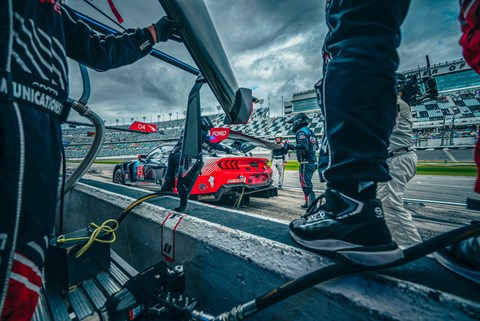
When the sun dips behind the grandstands, it casts an evocative Super 8 glow over the paddock and makes life even tougher for the drivers as they dive off the banking into Turn 1. It must be a relief when the circuit is enveloped in darkness, five hours in.
Every driver will tell you it’s crucial to remain hydrated at a 24-hour event in such temperatures, but already by 9pm in the Turn 4 campsite, fluid intake among spectators appears to have been exceptional. Fan Zack Dossett is a refreshingly coherent exception. Wearing a Ford Performance T-shirt with ear defenders perched just above his ears, the North Georgia native stands under a pop-up gazebo with an illuminated Stars and Stripes behind him, doing his best to get the live stream on his laptop connected to a TV.
He’s backing Penske Porsche to win outright, but hopes the Mustang GT3 goes well. ‘It’s really cool to see our domestic cars – the kind of things you see on the street – racing against supercars, it’s amazing,’ he says. ‘I really hope they can finish the race, and we’ve actually got a little wager going – my friend thinks they can win their class. Personally I’d like to see Ford come back with a prototype.’
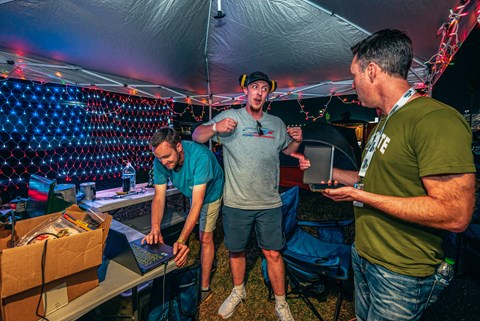
Marshall Matthews is sitting at the ‘bar’ he brings every year with friends, and says he preferred the previous Ford GT. Daytona regular Jorge Ortiz is here with a group of 25 from Puerto Rico. ‘This year I was thinking whether to come or not, but when I heard Ford would ⊲ bring the Mustang GT3, I had to watch that car.’
Overnight there’s trouble for Ford. Tincknell is back in the driving seat when a Corvette hits him from behind, cannoning him into the back of the #55 customer Mustang like Ronnie O’Sullivan cocked a leg over the baize and nailed a trick shot. The damaged #55 retires; six laps whizz by as the Ford crew repair Tincknell’s car.
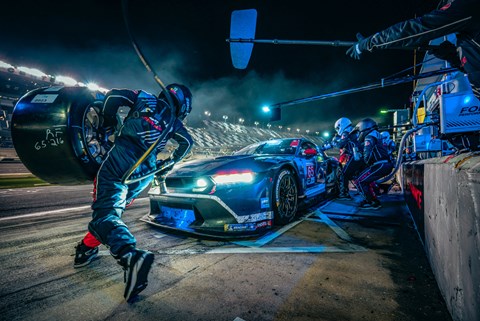
Dawn is spectacular as the clock ticks towards 7am, sunshine back-lighting clouds on the horizon like a lava lamp on warm-up. Cadillac leads Porsche overall, Paul Verhagen is 20 seconds up the road in the BMW M4 that leads GTD Pro, while the Mustangs are sixth and eighth in class.
Tincknell is playing rear gunner in #64 but he’s still on-point with high 1min 46sec laps. Only nine of the original 13 GTD Pro runners remain, but – yet more endurance-racing confusion – plenty of the (non-Pro) GTD cars are ahead.
Later, the sky darkens and brings a few dots of rain, but normal Florida service has long since resumed when the #65 Mustang pits at 11.14am with a partially collapsed rear wing. It’s rushed down the fire lane to the pit garage for repairs but never returns.
It leaves Tincknell’s car last ’Stang standing. I catch up with him on the pit wall at 12.15pm, unhelpfully squeezing his blisters moments before that last stint. Overall, though, he’s happy.
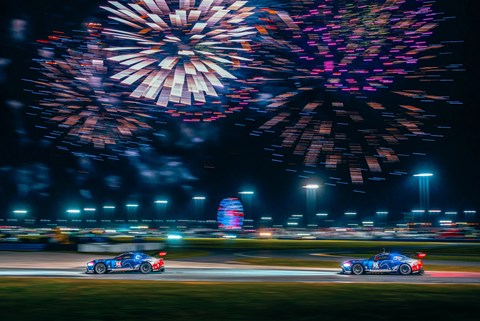
‘When I led the race in the first couple of hours, and we were the quickest car on track, I was like “Wow, that’s unexpected for the first ever race.” There’s tonnes we’ve learnt and can take away to the next race in Sebring, and without being hit from behind we’d be vying for the podium – an amazing achievement for the car on its debut.’
With that he’s gone, chasing a Corvette that’s still 18 seconds distant by the time officiating confusion ends this 24-hour race with 1min 35sec remaining. The record shows Porsche wins outright, Ferrari takes GTD honours and that Ford left Daytona with two DNFs, a distant 31st overall and sixth in class out of eight remaining GTD Pro entries.
But considering the Mustang’s not just been thrown in at the deep end but also punted up the rear, it’s a promising debut. Could a Ford upset the premium establishment at this year’s Le Mans? Wouldn’t be the first time.
Want more Mustang goodness? The July 2024 issue on sale now is packed with Ford icons – click here to subscribe and get access to our digital issue!
